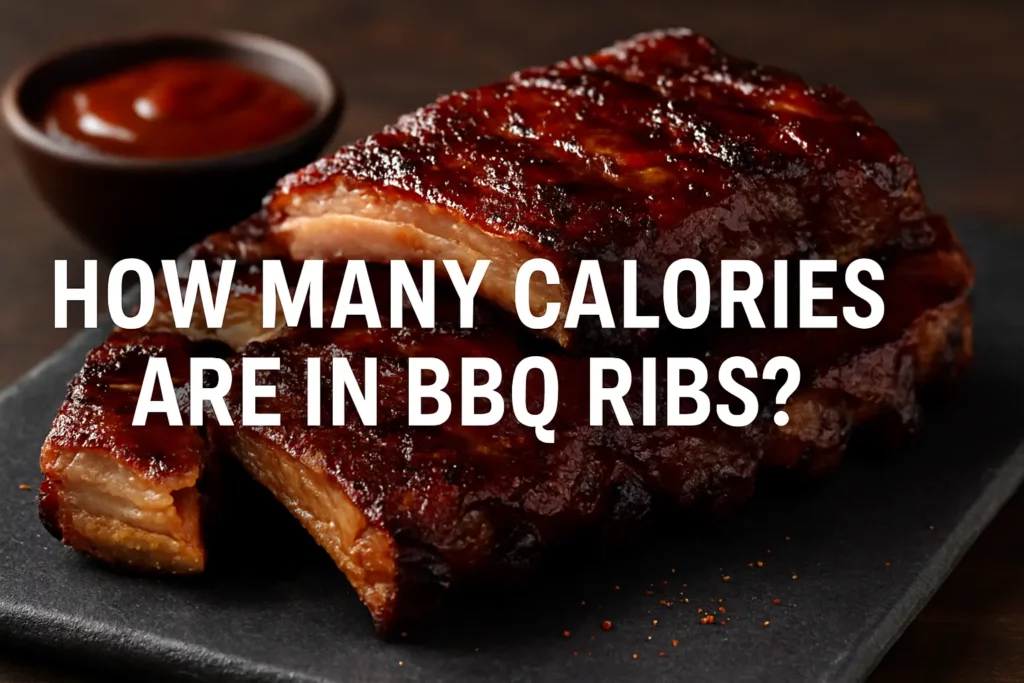This post may contain affiliate links. If you use these links to buy something we may earn a small commission. Thanks.
BBQ ribs are a mouthwatering staple of backyard cookouts, tailgates, and Southern-style feasts. Whether you prefer pork baby back ribs slathered in sticky barbecue sauce or a dry-rubbed rack of beef ribs straight off the smoker, there’s no denying their delicious appeal.
But how many calories are in those finger-licking ribs? The answer isn’t one-size-fits-all. The calorie count in BBQ ribs depends on several factors type of meat, cooking method, seasoning, sauce, and portion size. In this guide, we’ll break it all down to help you enjoy your favorite ribs without losing sight of your nutrition goals.
Why Knowing the Calories in BBQ Ribs Matters
BBQ ribs may be a protein-packed indulgence, but they’re also rich in fat and often served with calorie-dense sauces or sides. If you’re trying to manage your weight, monitor macros, or simply make informed food choices, understanding how many calories are in a rib meal is crucial.

Ribs aren’t inherently unhealthy, but their high fat content and generous use of sugar-laden sauces can add up quickly—especially when you’re not counting.
Factors That Affect Calorie Count in BBQ Ribs
Let’s explore the main variables that influence how many calories end up on your plate when you’re eating BBQ ribs.
1. Type of Rib
- Pork Baby Back Ribs: Smaller and leaner than other pork ribs, but still fatty. Popular in restaurants and backyard barbecues.
- Pork Spare Ribs: Larger and meatier than baby backs, with more fat and connective tissue.
- St. Louis-Style Ribs: Trimmed spare ribs with the cartilage removed—flatter and more uniform for cooking.
- Beef Ribs: Heavier, often meatier, and generally higher in calories due to increased fat content and size.
2. Cooking Method
- Grilling: Can render fat and reduce overall calories if cooked over direct heat.
- Smoking: Adds flavor but usually retains more fat.
- Baking or Roasting: May leave more fat in the meat compared to grilling.
- Frying: Rare, but significantly increases calorie count if battered or deep-fried.
3. Sauce vs. Dry Rub
- Dry Rub Ribs: Lower calorie option usually no added sugars or fats.
- Sauced Ribs: Adds anywhere from 30 to 150+ calories per serving depending on how much sauce is used.
4. Portion Size
This is perhaps the most important variable. A single rib isn’t going to wreck your diet, but a full rack might. Calories vary widely between a few bones, a 3 oz serving, or a full rack (which can be up to 2.5 pounds raw weight).
Calorie Estimates for Common Rib Types
Here’s a breakdown of how many calories are typically found in different types of BBQ ribs:
Pork Baby Back Ribs
- Per rib (meat only): ~80–100 calories
- 3 oz serving (meat only): ~250–290 calories
- Half rack (6 ribs): ~500–650 calories
- Full rack (12 ribs): ~1000–1300 calories
With sauce, add an additional 100–200 calories depending on how much is used.
Pork Spare Ribs
- Per rib (meat only): ~100–120 calories
- 3 oz serving: ~300–350 calories
- Half rack (5–6 ribs): ~600–750 calories
- Full rack (10–12 ribs): ~1200–1500+ calories
Spare ribs are fattier and more calorie-dense than baby backs.
St. Louis-Style Ribs
- 3 oz serving (meat only): ~280–330 calories
- Half rack: ~650–800 calories
- Full rack: ~1300–1600 calories
Because these are trimmed spare ribs, expect calorie values slightly below full spare ribs but higher than baby backs.
Beef Ribs
- Beef Back Ribs (3 oz meat): ~300–400 calories
- Short Ribs (3 oz meat): ~350–450 calories
- Single large beef rib (depending on cut): 400–700 calories
- Full plate (3-4 ribs): 1000–1600+ calories
Beef ribs are significantly higher in fat content, and portion sizes are usually larger.
Boneless Pork Ribs (Country-Style)
- 3 oz cooked portion (meat only): ~280–320 calories
- Per serving (with sauce): ~350–450 calories
Boneless ribs are convenient but often include added fat and rich marinades.
BBQ Sauce and Calorie Impact
One of the biggest calorie culprits in BBQ ribs isn’t the meat it’s the sauce. A few tablespoons of your favorite sticky-sweet barbecue sauce can add more calories than you’d expect.
Average Calories by Sauce Type
| Sauce Type | Calories per Tablespoon |
|---|---|
| Sweet BBQ Sauce | 50–70 calories |
| Honey BBQ Sauce | 60–80 calories |
| Spicy or Vinegar-Based | 30–50 calories |
| Sugar-Free BBQ Sauce | 10–20 calories |
A full rack of ribs may be brushed with 6–8 tablespoons (or more) of sauce—adding 300–500 calories just from sauce alone.
Tips for Reducing Sauce Calories
- Use dry rubs instead of sauce
- Brush lightly instead of slathering
- Opt for low-sugar or sugar-free BBQ sauces
- Serve sauce on the side for dipping instead of coating the ribs
Nutrition Breakdown Beyond Calories
When evaluating BBQ ribs, it’s not just about calories. Here’s a quick look at the typical macronutrients found in a 3 oz serving of pork baby back ribs (meat only):
- Calories: 270
- Protein: 21g
- Fat: 21g
- Carbohydrates: 0g (without sauce)
- Sodium: ~250–400 mg (varies by rub or sauce)
Health Pros:
- High in protein, essential for muscle repair and satiety
- Provides important nutrients like zinc, iron, and B vitamins
Health Cons:
- High in saturated fat
- Potentially high sodium levels (especially with sauce or marinades)
- High calorie density per serving
How to Enjoy BBQ Ribs Without Overdoing Calories
You don’t have to swear off BBQ ribs to stay healthy—just enjoy them more mindfully. Here are some ways to reduce the calorie load without sacrificing flavor.
1. Practice Portion Control
- Limit yourself to 3–4 ribs per meal
- Weigh your portion if possible (aim for 3–4 oz cooked meat)
- Don’t go for the full rack unless you’re sharing
2. Go for Dry Rubs
- Use a spice rub instead of calorie-heavy sauces
- Look for blends without added sugar or MSG
3. Choose Leaner Cuts
- Baby back ribs have slightly less fat than spare ribs
- Trim visible fat before cooking
- Remove skin or fatty edges if prepping boneless country-style ribs
4. Pair with Healthy Sides
- Skip fries, cornbread, or creamy slaws
- Serve with grilled vegetables, baked sweet potatoes, or leafy greens
- Add a fresh fruit salad or corn on the cob for balance
5. Control the Sauce
- Use a light hand when saucing
- Try mustard-based or vinegar-based sauces (fewer calories)
- Dilute thicker sauces with broth or vinegar for flavor without sugar
Conclusion
So, how many calories are in BBQ ribs? The answer depends on many variables, but here’s a quick summary:
- Baby back ribs (3 oz meat only): ~250–290 calories
- Spare ribs (3 oz): ~300–350 calories
- Beef ribs (3 oz): ~350–450 calories
- Sauce adds: ~30–70 calories per tablespoon
A full rack of ribs with sauce can easily exceed 1300–1600 calories. That said, with the right knowledge, you can enjoy BBQ ribs without sabotaging your health goals. Stick to sensible portions, opt for dry rubs or low-calorie sauces, and round out your meal with nutritious sides.
Grilling season doesn’t have to come with guilt just smart, informed choices.
FAQs
Q: Are BBQ ribs good for weight loss?
A: In moderation, yes. Choose leaner cuts, avoid heavy sauces, and monitor portion size.
Q: What’s the healthiest way to cook ribs?
A: Grilling or baking with a dry rub is the healthiest option. Avoid deep-frying or over-saucing.
Q: Do beef ribs have more calories than pork ribs?
A: Generally, yes. Beef ribs tend to be fattier and heavier, resulting in more calories per serving.
Q: How can I make my own low-calorie BBQ sauce?
A: Use tomato paste, vinegar, mustard, garlic, spices, and a sugar substitute like stevia or monk fruit.
